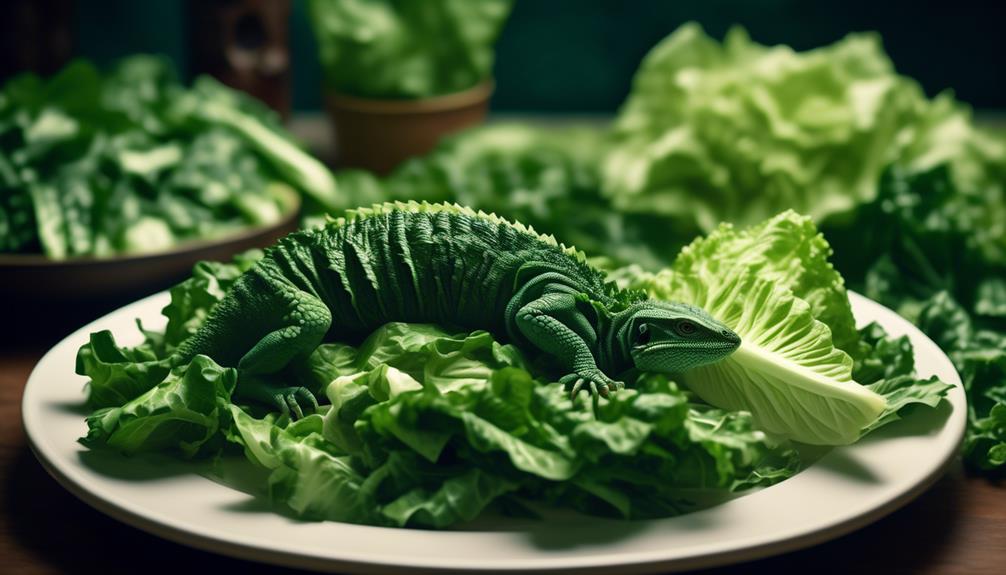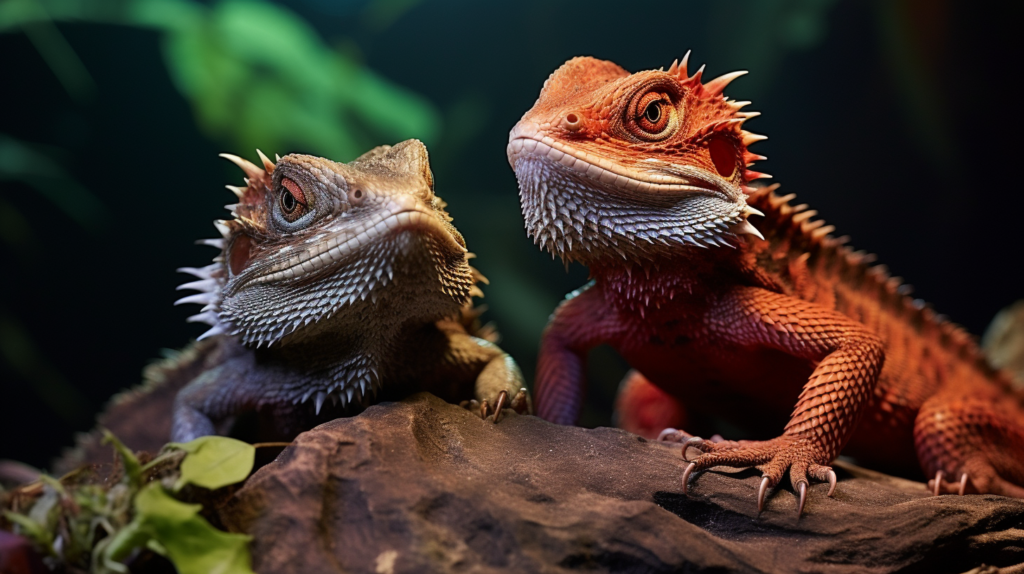Picture your bearded dragon basking under the warm glow of its heat lamp, eagerly awaiting its daily meal.
When considering the best greens to offer, the choice between collard greens and romaine lettuce can be quite challenging. Both have their benefits, but which one truly stands out in terms of nutrition and overall health for your scaly companion?
Let's delve into the debate and uncover the key differences that could have a significant impact on your bearded dragon's well-being.
Nutritional Value
When comparing the nutritional profiles of collard greens and romaine lettuce for meeting the dietary needs of bearded dragons, it's crucial to consider the fiber content and vitamin A levels.
Collard greens are known for their high fiber content, which is vital for the digestive health of bearded dragons. They provide a significant amount of dietary fiber, promoting proper digestion and gut health. Additionally, collard greens are rich in vitamin A, essential for maintaining good vision and supporting the immune system of bearded dragons.
On the other hand, romaine lettuce, while also a good source of fiber, contains lower levels of vitamin A compared to collard greens. Bearded dragons require adequate vitamin A for overall health, making collard greens a favorable choice in meeting this specific dietary need.
Therefore, when considering the nutritional value, collard greens appear to be a more beneficial option for providing essential fiber content and supporting optimal vitamin A levels for your bearded dragon's well-being.
Digestibility
Collard greens are generally more easily digested by bearded dragons due to their higher fiber content and lower water content in comparison to romaine lettuce. This difference in digestibility is influenced by the dietary preferences and digestive capabilities of bearded dragons.
When comparing the digestibility of collard greens and romaine lettuce for bearded dragons, several factors come into play:
- Fiber Content: Collard greens have a higher fiber content, which supports digestion and gut motility. This helps prevent digestive issues such as constipation, which can be a concern for bearded dragons.
- Water Content: Romaine lettuce has a higher water content, which can lead to looser stools and potential dehydration issues. The higher water content can also dilute essential nutrients, affecting overall nutrient absorption and digestion.
As primarily herbivorous reptiles, bearded dragons thrive on a diet that aligns with their digestive physiology. Collard greens, with their higher fiber and lower water content, better meet the dietary needs of bearded dragons, making them a more digestible and suitable option compared to romaine lettuce.
Calcium and Phosphorus Content
With a higher calcium to phosphorus ratio, collard greens offer a more balanced and suitable mineral composition for bearded dragons compared to romaine lettuce. Bearded dragons require a diet that provides a proper dietary balance of calcium and phosphorus to support their growth, bone health, and overall well-being. Collard greens contain a higher amount of calcium and a lower amount of phosphorus, which is essential for preventing metabolic bone disease, a common health issue in bearded dragons. A diet high in phosphorus and low in calcium, such as one based on romaine lettuce, can lead to an imbalance in the calcium-phosphorus ratio, negatively impacting the dragon's health.
This dietary imbalance can have severe health implications for bearded dragons. A low-calcium, high-phosphorus diet can hinder proper bone development and lead to skeletal abnormalities and weakness. It can also result in the leaching of calcium from the bones, making them brittle and prone to fractures. Additionally, an inadequate calcium to phosphorus ratio can affect other bodily functions, such as muscle contractions and nerve signaling, further compromising the dragon's health.
Therefore, ensuring that bearded dragons receive a diet rich in calcium, with an appropriate calcium to phosphorus ratio, is crucial for maintaining their overall health and well-being.
Oxalate Content
Incorporating collard greens into your bearded dragon's diet provides a lower oxalate content compared to romaine lettuce, contributing to the overall nutritional balance essential for their health. Oxalates are naturally occurring compounds found in many fruits and vegetables, and while they aren't harmful in moderate amounts, high oxalate levels can lead to health issues in bearded dragons.
- Oxalate Absorption: Collard greens have a reduced oxalate content, which means that the oxalates present are less likely to be absorbed into your bearded dragon's system. This can help prevent the formation of oxalate crystals in their kidneys, reducing the risk of kidney stones and related health problems.
- Dietary Oxalate Impact: Romaine lettuce, on the other hand, contains higher levels of oxalates. High dietary oxalate intake can interfere with the absorption of essential nutrients like calcium, leading to metabolic imbalances. By choosing collard greens over romaine lettuce, you can help maintain a healthier balance of oxalates in your bearded dragon's diet, supporting their overall well-being.
Feeding Recommendations
To ensure your bearded dragon receives optimal nutrition, it's important to consider the oxalate content when determining their feeding plan. Bearded dragons need a well-rounded diet that includes leafy greens, vegetables, and insects. When choosing between collard greens and romaine lettuce, keep in mind that while romaine lettuce has lower oxalate levels, it lacks essential nutrients for your dragon's overall health. Therefore, despite having higher oxalate levels, collard greens are a better choice due to their superior nutritional value.
When feeding your bearded dragon, consider the following recommendations:
- Feeding Frequency: Offer raw, finely chopped collard greens mixed with other leafy greens and vegetables 2-3 times per day.
- Insects: Feed insects dusted with a calcium supplement to your bearded dragon 3-5 times a week.
- Fruits: Offer small portions of fruits as an occasional treat once a week.
Providing your bearded dragon with a variety of nutrient-rich foods, including collard greens, and ensuring proper preparation methods will support their overall health and well-being.
Frequently Asked Questions
Can Bearded Dragons Eat Collard Greens and Romaine Lettuce Together in the Same Meal?
Absolutely, bearded dragons can enjoy a mixture of collard greens and romaine lettuce in one meal. This combination offers a range of nutrients and dietary diversity, which aligns with their feeding habits and preferences.
How Often Should I Feed My Bearded Dragon Collard Greens or Romaine Lettuce?
It's recommended to offer your bearded dragon collard greens or romaine lettuce every other day to maintain a balanced diet. Make sure to include a diverse selection of greens and vegetables to ensure a well-rounded nutritional intake.
Are There Any Specific Preparation Methods for Collard Greens and Romaine Lettuce That Are Best for Bearded Dragons?
When preparing collard greens and romaine lettuce for your bearded dragon, it's important to ensure that their nutritional value is retained. Start by thoroughly washing and chopping the greens, and then you can offer them to your pet as part of a well-rounded diet. Properly preparing these greens will help ensure that your bearded dragon receives the essential nutrients they need to stay healthy.
Can Bearded Dragons Eat the Stems and Ribs of Collard Greens or Romaine Lettuce, or Should They Only Eat the Leaves?
Absolutely, bearded dragons can consume the stems and ribs of collard greens and romaine lettuce. These components also offer nutritional benefits, such as fiber and vitamins. Make sure to cut the stems into small pieces to avoid choking hazards.
Are There Any Potential Allergic Reactions or Negative Effects That Bearded Dragons May Experience From Eating Collard Greens or Romaine Lettuce?
Feeding collard greens or romaine lettuce can provide essential nutrients and contribute to the overall well-being of bearded dragons. Nevertheless, it's important to be cautious of potential adverse reactions and negative impacts, and closely observe their intake.
Conclusion
In conclusion, considering the nutritional value, digestibility, and calcium content, collard greens emerge as a superior option for bearded dragons compared to romaine lettuce.
Despite the popularity of romaine lettuce, it lacks the necessary nutrients required for a bearded dragon's diet.
When it comes to feeding your reptile companion, it's important to make a wise choice for their health and well-being, as appearances can be deceiving.


